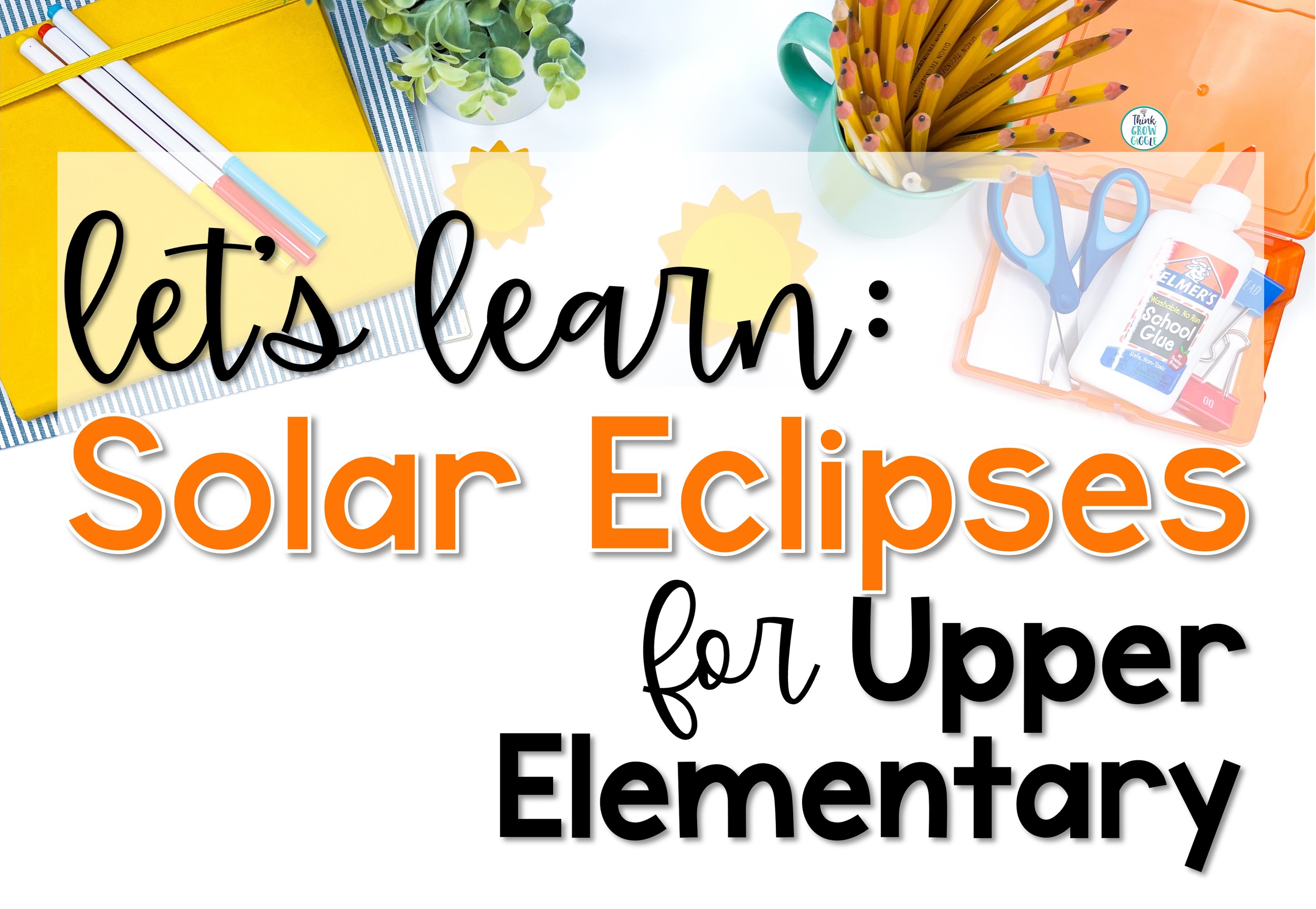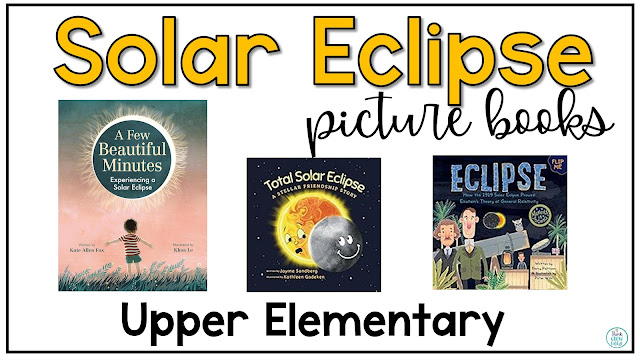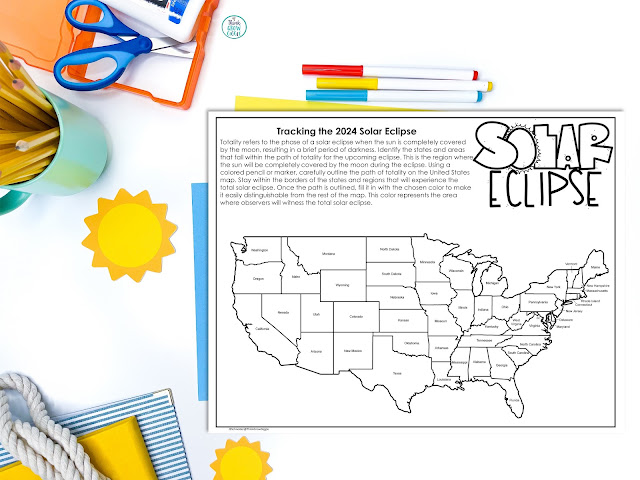Ready for the 2024 solar eclipse in your upper elementary classroom?
When learning about phenomena, upper elementary
students dive right in! Their curiosity lends itself to conversations that help them understand tricky concepts like solar and lunar eclipses. That is
why I love bringing current events into the classroom!
What is a solar eclipse?
A solar eclipse occurs when the moon positions itself and
passes between the sun and Earth, casting a shadow that either partially or
completely conceals the sun's rays. This is considered a rare and extraordinary
event because the moon does not orbit in the exact same path as the sun and Earth
do.
Teaching about Solar Eclipses
Since solar eclipses are rare, bringing them into the
classroom is a great way to make learning authentic and harness your students’
excitement into meaningful activities. Not sure how to get started teaching
about solar eclipses? Try these ideas! From hands-on experiments to creative and art-inspired tasks, each activity is designed to not only ignite your students'
curiosity but also deepen their comprehension of the upcoming solar eclipse.
1. Read a Picture Book About the Solar Eclipse
I love turning to picture books when kicking off any new unit, especially tricky science concepts! Since solar eclipses are rare, I can feel confident that the books I select to share with students will be new to them and help them visualize and see eclipses through the books' illustrations before the big event occurs! Reading picture books aloud to upper elementary students helps build background knowledge, allowing all students to have some understanding of the concept or phenomenon before our learning begins.
👉Here are three of my favorites for upper elementary...
- How the 1919 Solar Eclipse Proved Einstein's Theory of Relativity by Darcy Pattison
- Total Solar Eclipse by Jayme Sandberg
- A Few Beautiful Minutes by Kate Allen Fox
2. Compare and Contrast Solar and Lunar Eclipses
Bringing nonfiction reading passages to your science lessons is a great way to connect content with informational reading skills. When I taught fifth-grade science, I saw firsthand the disconnect students had with using different nonfiction reading strategies they had learned throughout the years with science content materials they were resading. Since then, I always find ways to bring nonfiction reading skills into science class. One easy way to do that is to use informational passages to help students understand eclipses.
Want to give it a try? One way you can try using nonfiction strategies like a study of text structure during your solar eclipse study is to have students focus on comparing and contrasting solar and lunar eclipses. This one idea will have your students comparing, contrasting, critical thinking, and most importantly, understanding the differences between the two.
💡Follow these three steps to compare solar & lunar eclipses:
- Read nonfiction passages about both lunar and solar eclipses.
- Have students interact with the text by highlighting important information about each eclipse in a different color. This will help them complete a Venn diagram easily about the two different eclipses.
- Sketch! Bring out the colored pencils and have students create sketch illustrations with pictures to show the difference between these eclipses. Go one step further and have students include labels and captions for their illustrations.
3. Watch a Video About Solar Eclipses to Visualize
Lunar and solar eclipses are tricky concepts!
Help your students see eclipses in action by weaving kid-friendly videos about lunar and solar eclipses into your unit. You can easily show these before any lesson, during snack, or after recess. Go one step further by having students write on sticky notes four important concepts from the videos. Collect all the students' sticky notes when the video ends and add them to a chart paper. Share the ideas that the students recorded, looking for patterns or repeated information. This will help you zoom in on the important concepts from the videos.
Try one of these lunar and solar eclipse videos:
- Getting Ready for the Eclipse! (SciShowKids) about 13 minutes
- What Will Happen During the Solar Eclipse? (SciShowKids) about 4 minutes
- Eclipses for Kids: Solar and Lunar (Smile and Learn) about 3 minutes
- Solar Eclipse (Dr. Binocs) about 3 minutes
- What is a Solar Eclipse? (NASSA) about 2 minutes
Kindly note: As with any video you show your students please preview the video to ensure they are appropriate for your cohort of students!
4. Map Out the Totality
Discuss the path of the 2024 eclipse using a United States map to track it, discussing its totality. Totality is a rare and captivating occurrence that occurs only in specific locations along the eclipse path.
Totality refers to the brief and spectacular phase of a
solar eclipse when the moon completely covers the sun, casting a shadow on
Earth and sending the immediate surroundings into darkness. During totality,
the sun's bright disk is entirely covered, revealing the solar corona—a halo
of hot, ionized gas surrounding the sun. This unique and awe-inspiring moment
allows observers within the path of totality to witness the sun's outer
atmosphere, experience a temporary twilight-like atmosphere, and marvel at the
celestial alignment of the moon and the sun.
How to dive into the totality:
- Have students create the path on a United States Map (grab a free template below)
- Refer to this → NASA site for the 2024 eclipse path
- Heading outside to view the eclipse? Provide these safety glasses for students!
Grab the FREE solar eclipse mini pack here:
5. Get Up and Moving with a Simple Experiment
What better way to explore science concepts than with hands-on science experiences!
💡Try this idea:
Simulate the phases of a solar eclipse using the students as models. Have each group of three students color and create a sun, moon, and earth using different size paper plates. The largest paper plate is the sun, the smallest paper plate is the moon, and the middle plate is the earth. Students can use construction paper or markers to decorate each plate. Once each plate is created, have students hold them over their heads and demonstrate how the moon blocks the sun's light during the eclipse, ensuring that all three students stand in the right positions. Have them sketch how they stood to show the solar eclipse in action!
6. Solar Eclipse Writing Prompts
Learning about any topic during science certainly lends itself to writing informational pieces. Students can write informative writing pieces to show or explain what they learned, share their opinions, and explain how something works. You can also get more creative with writing projects during science. Have your students go outside the box and write and create acrostic poems, descriptive paragraphs, and narrative pieces that weave in facts they learned.
Try some of these prompts during your solar eclipse unit, and don't forget to grab the free solar eclipse acrostic poem template and these prompts above.
- Imagine you are an astronaut exploring outer space. Write a journal entry about the solar eclipse you witnessed from your spaceship.
- Pretend you are a scientist studying the solar system. Write a report explaining why solar eclipses happen and how they affect Earth.
- If you could travel to the moon during a solar eclipse, what would you see and experience? Describe your lunar adventure in detail.
- Create a dialogue between the sun and the moon during a solar eclipse. What do they say to each other? How do they feel about this rare event?
- Write a free-form poem inspired by the beauty and mystery of a solar eclipse. Use descriptive language to capture the emotions and atmosphere.
- Draw a picture of a solar eclipse and write a short paragraph explaining the different phases. What happens during each stage?
- Pretend you are a news reporter covering the solar eclipse for a kids' newspaper. Write an article detailing the important facts and interesting aspects of the event.
- If you were a superhero with powers related to the sun and moon, how would you use them during a solar eclipse? Create a superhero comic featuring yourself as the hero.
- Write a persuasive essay convincing your classmates that everyone should take a break from their regular activities to observe a solar eclipse. What makes it a special and educational experience?
- Write a letter to an alien pen pal explaining the concept of a solar eclipse on Earth. How would you describe the event to someone from another planet?
7. Get Creative with Solar Eclipse Art Projects
I love to have students use creative thinking and their art skills to show what they learned! Wrap up your unit on the solar eclipse with one of these ideas to help synthesize their learning.
The world of solar eclipses is fascinating and mysterious, especially for our upper elementary students! Whether your students are aspiring astronauts, budding scientists, or someone who loves a good adventure, witnessing a solar eclipse is a memorable experience and one we should support as educators. Add different hands-on activities, art-inspired tasks, and outside-of-the-box writing projects to your solar eclipse lesson plans to help inspire students! Mark your calendars for the April 2024 eclipse, try some of these activities, and watch your students be inspired to learn as much as possible!
Happy teaching! : )
You will also love reading:
Check out these solar eclipse activities HERE.
LOVE these ideas? Pin to save!
*affiliate links: “Think Grow Giggle is a participant in the Amazon Services LLC Associates Program, an affiliate advertising program designed to provide a means for sites to earn advertising fees by advertising and linking to Amazon.” (source: Section 5)




















